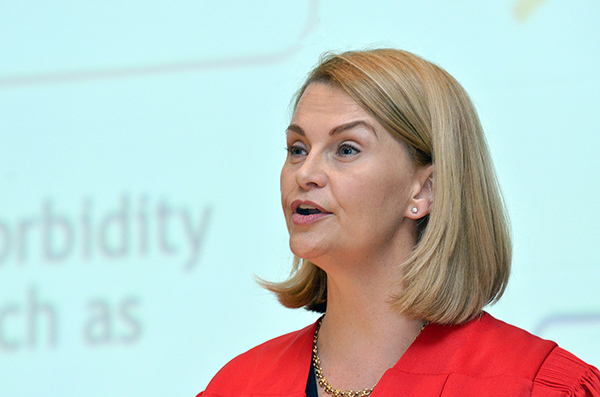
Prof Corinna Walsh during her inaugural lecture on ‘Nutrition in Transition’.
Photo: Stephen Collett
“The first 1 000 days, from conception to two years, is a critical time to ensure that the early environment is optimal to guarantee the best outcomes,” Prof Corinna Walsh, Professor in the Department of Nutrition and Dietetics at the University of Free State (UFS), said. She delivered her inaugural lecture on Nutrition in Transition on 30 October 2017.
During her lecture, Prof Walsh explained how an unfavourable early environment impacts on the health and well-being of both children and adults. She gave an overview of the prevalence of hunger and food insecurity in the Free State, and described the shift that has occurred from healthier traditional diets to more unhealthy Western diets accompanied by sedentary lifestyles. These patterns are closely linked to the triple burden of malnutrition, including undernutrition, micro-nutrient malnutrition, and obesity. Finally, Prof Walsh highlighted the double burden of disease, focusing on chronic lifestyle diseases on the one hand, and infectious diseases such as HIV/AIDS and TB on the other hand.
“Preparing for this lecture has given me the opportunity to reflect on the almost thirty years of my research journey, a process that I thoroughly enjoyed,” said Prof Walsh.
“It was a privilege to share the work of my research team with fellow colleagues as well as with family and friends,” she said. Prof Walsh is a National Research Foundation C-rated researcher and also served on the Board of the Medical Research Council from 2005 to 2010.
Foundations for health, growth established early
The first 1 000-day window focuses on the time between conception and the second birthday. “This is a critical period for growth and development,” Prof Walsh said. It is a unique period, as the foundations for health, growth, and neuro-development are established. It also focused on the implications of malnutrition, which is the biggest risk factor contributing to the global burden of disease.
Research identifies burden of disease
Her research has made a considerable contribution to identifying the burden of disease in the Free State. “It focuses on both malnutrition and infectious diseases such as HIV and TB on the one hand, and chronic lifestyle diseases such as obesity, diabetes, and hypertension on the other,” she said. The research team have also implemented a number of interventions to address these challenges, including programmes that have assessed the impact of nutrition-education programmes, household food gardens, and nutrition supplementation.